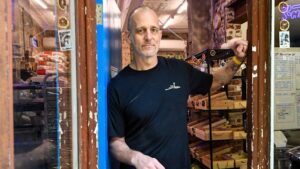
Leichhardt’s cultural identity is undergoing a transformation, raising questions about the future of Sydney’s traditional Italian heart. On a drizzly Saturday in October, thousands of Sydneysiders defied the weather to attend the 39th Norton Street Italian Festa, a vibrant celebration of the suburb’s Italian heritage featuring live entertainment, cooking demonstrations, and a rich array of local culinary offerings.
Ilario Ventolini, president of Viva Leichhardt, reported to realcommercial.com.au that this year’s festival attracted the largest crowd in a decade, with an estimated 200,000 attendees.
“The police said there was around 180,000, but their guess is always a little more conservative. I can tell you that at 9:30 in the morning there were already 40,000 people on the street and we hadn’t even opened yet. It was unbelievable.”
Like many high streets in Sydney and across Australia, Norton Street has experienced its share of ups and downs. From its bustling mid-century heyday as the epicenter of Sydney’s Italian community, it has evolved through gentrification, shifting demographics, and a slower pace of trade. In 2001, the Inner West Council officially designated the precinct around Marion and Norton streets as ‘Little Italy’. Shortly thereafter, Norton Street began to grapple with an identity crisis.
The Changing Face of Little Italy
Norton Street Italian Festa might draw thousands once a year, but does it reflect the demographic and everyday reality of the strip in 2025? Ventolini emphasizes the importance of the tradition, saying,
“It’s an important tradition celebrated since the Italians first migrated to the area. And these days we’re not only celebrating the Italian heritage, but the vibrant, diverse and welcoming community we are today.”
The title Little Italy was officially conferred in 2001, but the name dates back to the post-World War II era when thousands of Italian migrants settled in Leichhardt and neighboring suburbs. Norton Street became the cultural and commercial heart, bustling with Italian cafés, trattorias, delis, and social clubs.
Charlie Pignataro of Il Cugino Pizzeria remembers the street’s vibrant past,
“If you were Italian, or simply wanted good Italian food, this was the place to be. The strip was always humming past midnight with so many people. There was always life, always something happening.”
However, the number of Italian-born residents in Leichhardt has steadily declined over the past few decades. According to the Australian Bureau of Statistics, Italian-born residents decreased from 493 in 2016 to 371 in 2021, representing only 2.4% of the suburb’s population. Over the same period, those identifying as having Italian ancestry also dropped.
Demographic Shifts and Economic Challenges
Despite these changes, the proportion of Leichhardt residents reporting Italian ancestry rose from 4.7% to 6.9% between 2011 and 2021, suggesting a return of some Italian Australians to their ancestral roots. Buyer’s agent Nick Viner notes a demographic shift,
“Ten years ago, it was people in their early thirties moving in. Now it’s more late thirties, according to the most recent census. And if we’re talking trends, I’ve definitely noticed more downsizers coming into the area.”
Viner also observes a quieter Norton Street, with businesses closing earlier than in the past. Pignataro concurs,
“We close around 9pm now, because after that business pretty much slows down. I don’t know if people just got used to going to bed earlier or spending less after COVID – it’s hard to say.”
The Future of Norton Street
The decline of the Italian Forum, a once lively hub of cafés and restaurants, is perhaps the most noticeable change. Initially marketed in 1989 as a cultural and economic revitalization project, the Forum’s energy waned by the mid-2000s. In 2023, major portions of the site were sold to property developer Bob Patterson, yet little progress has been made in revitalizing the complex.
Despite these challenges, there are signs of renewal. The arrival of Teatro, a new 300-seat indoor theatre, has sparked renewed interest. Its first production, a sold-out run of The Addams Family, has drawn hundreds back to the precinct. Ventolini is optimistic,
“They’re bringing some life back into the Forum, which is fantastic. It’s exactly the kind of thing that could encourage restaurants to reopen in the piazza.”
In 2024, Leichhardt was one of 32 districts to receive funding under the NSW Government’s Uptown District Acceleration Program, aimed at revitalizing high streets and community hubs. Ventolini sees the annual Norton Street Italian Festa as central to this mission, with plans to expand into nighttime celebrations for its 40th anniversary.
Charlie Pignataro believes that everyday changes, such as cheaper rents and more parking, could make a significant difference.
“On a Friday night when I’m making pizzas, I’ll look out the window and see customers who’ve booked tables circling the block trying to park. If they could fix that, it would really help.”
As Norton Street continues to evolve, the community remains hopeful that the blend of tradition and innovation will ensure the enduring legacy of Sydney’s Little Italy.





